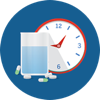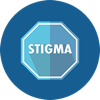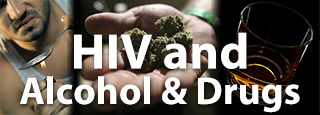PrEP
PrEP (pre-exposure prophylaxis) is medicine people at risk for HIV take to prevent getting HIV from sex or injection drug use. When taken as prescribed, PrEP is highly effective for preventing HIV.
This section answers some of the most common questions about PrEP.
This section answers some of the most common questions about PrEP.
HIV Basics | About HIV | HIV Transmission | HIV Prevention | PrEP | PEP | HIV Stigma
What is PrEP?

PrEP (pre-exposure prophylaxis) is an internationally recommended HIV prevention method, in which people who do not have HIV take the HIV medication emtricitabine and tenofovir disoproxil fumarate every day, to prevent getting HIV. When taken daily PrEP is 99% effective at preventing HIV. In New Zealand we use the generic form of PrEP which is a single pill taken once daily.
How effective is PrEP?
PrEP is highly effective for preventing HIV.
- PrEP reduces the risk of getting HIV from sex by about 99% when taken as prescribed.
- Although there is less information about how effective PrEP is among people who inject drugs, we do know that PrEP reduces the risk of getting HIV by at least 74% when taken as prescribed.
- PrEP is much less effective when it is not taken as prescribed.
Is PrEP safe?
- PrEP is safe but some people experience side effects like diarrhea, nausea, headache, fatigue, and stomach pain. These side effects usually go away over time.
- Tell your health care provider about any side effects that are severe or do not go away.
How long do I have to take PrEP before I am protected?
Current evidence suggests that for both rectal and vaginal exposure, high protection is achieved after 7 days of daily dosing. Women need to maintain high adherence to daily dosing of PrEP to maintain adequate drug levels in vaginal/cervical tissues. No data are yet available to inform considerations of protection for male insertive sex partners. Limited data exist for transgender and gender-diverse people therefore extra attention to daily dosing is recommended.
WHO recommends that because MSM achieve highly protective levels of PrEP medications with a single loading dose of two PrEP tablets they can take this PrEP loading dose whether they intend to commence daily PrEP, or PrEP211. High protection is achieved 2 hours after the loading dose.
WHO recommends that because MSM achieve highly protective levels of PrEP medications with a single loading dose of two PrEP tablets they can take this PrEP loading dose whether they intend to commence daily PrEP, or PrEP211. High protection is achieved 2 hours after the loading dose.

Is PrEP right for me?
PrEP may be right for you if you test negative for HIV, and any of the following apply to you:
You have had anal or vaginal sex in the past 6 months and you
- have a sexual partner with HIV (especially if the partner has an unknown or detectable viral load),
- have not consistently used a condom, or
- have been diagnosed with an STD in the past 6 months.

You inject drugs and you
- have an injection partner with HIV, or
- share needles, syringes, or other equipment to inject drugs (for example, cookers).

You have been prescribed PEP (post-exposure prophylaxis) and you
- report continued risk behaviour, or
- have used multiple courses of PEP.

If you are a woman and have a partner with HIV and are considering getting pregnant, talk to your doctor about PrEP if you’re not already taking it. PrEP may be an option to help protect you and your baby from getting HIV while you try to get pregnant, during pregnancy, or while breastfeeding.

How do I get PrEP?
Currently emtricitabine and tenofovir disoproxil fumarate are approved for use as PrEP by Medsafe in New Zealand, so your GP can prescribe it for you - checkout the provider section, if you want information to give your GP, or to find someone that is already prescribing.
How do I know if I’m eligible to be prescribed funded PrEP?
To be eligible for funded PrEP your GP will simply need to confirm you are HIV negative and that your doctor considers you at elevated risk of HIV exposure making PrEP clinically appropriate.
Funded PrEP is available to anyone, regardless of gender or sexual orientation.
Funded PrEP is available to anyone, regardless of gender or sexual orientation.
Starting, using and stopping oral PrEP?
Daily PrEP
A daily PrEP regimen is effective for everyone to reduce the risk of HIV acquisition and involves taking a single daily tablet at approximately the same time (a couple of hour either side is okay).
Start by taking one dose daily for 7 days prior to potential exposure, then continue daily and you are able to stop 7 days after the last potential exposure.
PrEP211
The PrEP211 regimen can be used to prevent sexual acquisition of HIV by cisgender men and trans and gender diverse people assigned male at birth who are not taking exogenous estradiol-based hormones. PrEP211 is effective for all positioning (insertive and/or receptive).
PrEP211 involves taking a loading dose of PrEP where two tablets of PrEP are taken together as early as 24 hours before sex (preferably), or as late as 2 hours before sex. Continue to take one dose per day until two days after the day of the last potential sexual exposure.
Hepatitis B virus (HBV) infection is not a contraindication for PrEP211.
For more details on how PrEP211 works as well as examples, click here.
A daily PrEP regimen is effective for everyone to reduce the risk of HIV acquisition and involves taking a single daily tablet at approximately the same time (a couple of hour either side is okay).
Start by taking one dose daily for 7 days prior to potential exposure, then continue daily and you are able to stop 7 days after the last potential exposure.
PrEP211
The PrEP211 regimen can be used to prevent sexual acquisition of HIV by cisgender men and trans and gender diverse people assigned male at birth who are not taking exogenous estradiol-based hormones. PrEP211 is effective for all positioning (insertive and/or receptive).
PrEP211 involves taking a loading dose of PrEP where two tablets of PrEP are taken together as early as 24 hours before sex (preferably), or as late as 2 hours before sex. Continue to take one dose per day until two days after the day of the last potential sexual exposure.
Hepatitis B virus (HBV) infection is not a contraindication for PrEP211.
For more details on how PrEP211 works as well as examples, click here.
Can I stop and start the pills?
Yes, if you want to take a break, you can.
Discontinuing PrEP
WHO recommends that cisgender men and trans and gender diverse people assigned male at birth who are not taking exogenous estradiol-based hormones can safely cease PrEP by taking a dose of PrEP 24 and 48 hours after their last at-risk sexual exposure.
Discontinuing daily PrEP for other populations
PrEP should be continued for 7 days after the last at-risk sexual exposure
Discontinuing PrEP
WHO recommends that cisgender men and trans and gender diverse people assigned male at birth who are not taking exogenous estradiol-based hormones can safely cease PrEP by taking a dose of PrEP 24 and 48 hours after their last at-risk sexual exposure.
Discontinuing daily PrEP for other populations
PrEP should be continued for 7 days after the last at-risk sexual exposure
What tests are involved?
An HIV test is required as you should not initiate PrEP if you are HIV Positive – additional medication is required for treating HIV.
PrEP services are an opportunity to provide comprehensive sexual and reproductive health services, including STI testing and treatment. PrEP services also offer an opportunity to integrate human papillomavirus (HPV) screening, which would contribute to preventing cervical and anal cancer. Testing for STIs among PrEP users, with or without symptoms, is suggested at initiation and regularly thereafter (such as every three to six months).
If you are at risk of HIV you may also be at risk of Hepatitis B and Hepatitis C as they have similar routes of transmission. It is highly recommended to be tested for Hepatitis Surface Antigen (HBsAg) and Hepatitis C antibodies once, at or within three months of PrEP initiation.
Impaired kidney function is a contraindication for TDF-based oral PrEP. Given the low risk of kidney impairment measuring kidney function for people without known kidney related comorbidities is: optional when aged under 30; optional/conduct once within 3 months of initiation for under 50, every 6 to 12 months for over 50 and for people with comorbidities. Waiting for kidney function tests should not delay initiation of PrEP.
PrEP services are an opportunity to provide comprehensive sexual and reproductive health services, including STI testing and treatment. PrEP services also offer an opportunity to integrate human papillomavirus (HPV) screening, which would contribute to preventing cervical and anal cancer. Testing for STIs among PrEP users, with or without symptoms, is suggested at initiation and regularly thereafter (such as every three to six months).
If you are at risk of HIV you may also be at risk of Hepatitis B and Hepatitis C as they have similar routes of transmission. It is highly recommended to be tested for Hepatitis Surface Antigen (HBsAg) and Hepatitis C antibodies once, at or within three months of PrEP initiation.
Impaired kidney function is a contraindication for TDF-based oral PrEP. Given the low risk of kidney impairment measuring kidney function for people without known kidney related comorbidities is: optional when aged under 30; optional/conduct once within 3 months of initiation for under 50, every 6 to 12 months for over 50 and for people with comorbidities. Waiting for kidney function tests should not delay initiation of PrEP.
Information contained in this section is a reproduction for New Zealand of content published on the CDC (Centers for Disease Control and Prevention) Website
Join Body Positive
By becoming a member you will be able to access all the services we offer, as well as support and updates to help you live better.
Newsletter
Want to be keep up with whats happening at Body Positive?
Subscribe to our newsletter below by submitting your e-mail address.
Subscribe to our newsletter below by submitting your e-mail address.























